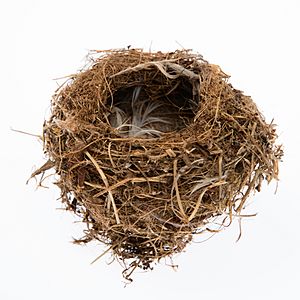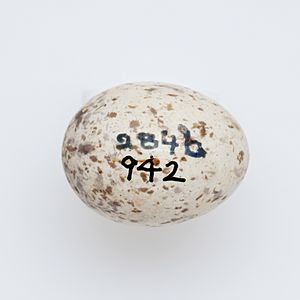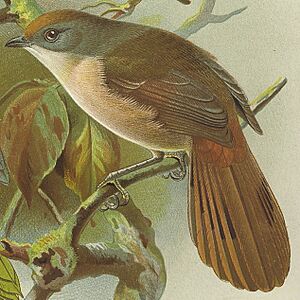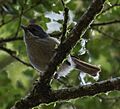Pipipi facts for kids
Quick facts for kids Pipipi |
|
|---|---|
 |
|
| Conservation status | |
| Scientific classification | |
| Genus: |
Mohoua
|
| Species: |
novaeseelandiae
|
| Synonyms | |
|
Finschia novaeseelandiae |
|
The pipipi (Māori: pīpipi), also called the brown creeper, is a small bird found only in the South Island of New Zealand. These birds are experts at finding and eating insects. They use their strong legs and toes to hang upside down while they look for food on branches and leaves.
Contents
What Does the Pipipi Look Like?
The pipipi has a mix of warm brown and chestnut colors on its back. Its belly is a lighter brown. Its head has patches of chestnut and dark brown, with some spots and streaks. The area around its face can be a dark gray. A white stripe above its eye helps to tell it apart from other birds. Its legs and beak are a pinkish-gray or brown. The tail is long and has a dark bar at the tip. Its eyes are a dark reddish-brown.
Pipipi eggs are white to dark pink with reddish-brown speckles. They are about 2 centimeters (0.8 inches) long.
Male and female pipipi look very similar. Young pipipi also look a lot like adults. You can tell young birds apart before May because they have yellow parts around their beak and dark brown legs. Young pipipi also have a grayer head and no white stripe behind their eye.
Male pipipi weigh about 13.5 grams (0.48 ounces). Females are a bit lighter, weighing around 11.0 grams (0.39 ounces). Both are about 13 centimeters (5 inches) long.
Where Do Pipipi Live?
Global and New Zealand Homes
Pipipi live only in the South Island of New Zealand, south of Cook Strait.
They are found in many forests across the South Island. Some small groups live in places like Banks Peninsula and Stewart Island. They are very common on islands near Fiordland and Marlborough Sounds. Pipipi are especially common on Cod Fish Island.
Favorite Places to Live
Pipipi can live in many different types of places. They like native beech and podocarp forests. They also live in areas with willow, gorse, and broom plants. You can find them in new forests growing back, and in manuka/kanuka scrub. They live from the sea all the way up to the treeline in the mountains.
They especially like the western and northern parts of the South Island. This includes the Fiordland area. They also live in the dry scrub forests of Marlborough and Canterbury.
When pipipi build nests for their babies, they like to choose dense plants high up in the forest trees.
Pipipi numbers dropped a lot when Europeans first came to New Zealand. This was likely because many lowland forests were cut down. If more of these forests were still around, pipipi would probably live there too.
The Pipipi Life Cycle

Mating and Raising Young
Pipipi pairs usually stay together for life. They only find a new mate if their old one dies. Pairs strongly protect their home area during the breeding season. They also protect it a little during the rest of the year. Male and female pipipi sing together to keep their bond strong.
In September, the female builds a nest. She uses bark, twigs, grass, moss, and leaves. She sticks it all together with spiderwebs and lines it with feathers and wool. The nest is shaped like a deep cup. It takes her about 5 to 17 days to build it. Nests are usually built in thick tree branches or bushes, between 1 and 10 meters (3 to 33 feet) off the ground. The male guards the female while she builds the nest and for a few days before she lays eggs.
Pipipi Songs
Pipipi sing all year, except in late summer. Their territorial songs are loudest in spring. Only male pipipi sing a long territorial song. Each male's song is a bit different. A male's song is a mix of musical whistles and harsh notes. The female's song is a quick series of short notes, with the last one being high-pitched and long.
The pipipi's song is a short, pleasant warble. It sounds different from other bird songs. However, their "conversational chatter" can sound like other small bush birds.
No Long Journeys
Pipipi that live high in the mountains will fly down to lower areas in winter. They form groups there. Other than that, pipipi do not migrate (travel long distances).
Laying Eggs

Female pipipi can lay eggs from late September to early February. Males guard the females before and during the egg-laying period. Females usually lay two sets of eggs each breeding season. They lay most eggs in early October and late November. If a nest fails early, they might lay up to four sets of eggs. However, they will only raise two sets of chicks.
Pipipi lay 2 to 4 eggs, one every 24 hours. Each egg is about 18.5 mm by 14 mm and weighs about 1.9 grams. The female sits on the eggs alone for 17 to 21 days until they hatch.
Raising Chicks
Both parents feed the young birds until they are ready to leave the nest. This happens when they are about 18 to 22 days old. When the female starts sitting on a second set of eggs, the male takes over feeding the first group of young birds.
Sometimes, if a pair's nest fails, they will help feed chicks in another pipipi's nest. Young pipipi are fed until the end of winter before they become independent. This takes about 35 to 65 days. Pipipi are also known to feed a much larger long-tailed cuckoo chick during the summer. Pipipi are the main birds that long-tailed cuckoos trick into raising their young in the South Island.
Young Pipipi
Once young pipipi can take care of themselves, they form groups with other young birds from that year. These groups stay together through autumn and winter. These flocks can have up to 60 birds. They often mix with other forest birds like fantails and silvereyes. Young pipipi can start breeding when they are one year old. Young males learn their songs from male pipipi in nearby areas, not from their parents. For the first week after leaving the nest, young pipipi huddle together during the day. This helps their tail feathers grow and their wings get stronger.
Changing Feathers
Pipipi change their feathers (moult) in late summer. This is the only time of year when pipipi are not singing all day.
How Long Do Pipipi Live?
About 63% of all pipipi eggs hatch. Then, 36% of those chicks grow up and leave the nest. Predators cause about 62% of egg loss and 66% of chick loss. On average, pipipi successfully raise about 1.6 young birds per adult each year.
In one study, 82% of adult pipipi survived each year. Pipipi can live for about 5 years.
What Do Pipipi Eat and How Do They Find Food?
Pipipi Food
Pipipi mainly eat small creatures without backbones, called invertebrates. But they also eat fruits. Their favorite foods are beetles, moths, spiders, flies, and caterpillars. They also eat ripe fruits from native plants, especially in autumn.
How They Find Food
Pipipi usually find invertebrates on small branches and leaves high in the trees. They sometimes hang upside down from branches to look for food. While they mostly pick food from leaves, they also find invertebrates under loose bark or on large branches. They rarely look for food on the ground. They prefer to search more than 2 meters (6.5 feet) above the ground.
Sometimes, breeding pairs look for food together. But more often, pipipi search in groups of 3 to 12 birds. These groups usually include family members, young birds, and sometimes other pairs when it's not breeding season. During the breeding season, pairs will look for food together in their own territory.
Males and females have slightly different beak sizes. This might help them avoid competing for food. Males generally have larger beaks, so they can eat a wider range of foods.
Who Are the Pipipi's Enemies?
Long-tailed Cuckoos
Pipipi are one of the main birds that long-tailed cuckoos trick into raising their young. You might see a pipipi feeding a much larger cuckoo chick in the summer. Pipipi can also be affected by shining cuckoos.
Pipipi often push long-tailed cuckoo eggs out of their nests. This is because pipipi build open nests, not closed ones. An open nest lets in more light, making it easier for the pipipi to spot a strange egg. Even so, the long-tailed cuckoo lays eggs that look very similar to pipipi eggs. Pipipi also try to scare away long-tailed cuckoos in spring and summer. They do this by making warning calls. The whole group hears the calls and surrounds the cuckoo. They flap their wings, raise their tails, hop around, and call until the cuckoo leaves. Pipipi have been seen doing this to cats, rats, stoats, larger birds, and even humans!
European Settlement and Predators
Pipipi numbers went down after Europeans settled in New Zealand. This was because new animals like cats, rats, and stoats were brought in. Stoats and black rats often eat pipipi eggs and young chicks. The loss of many lowland forests also hurt pipipi numbers. However, their numbers seem to be stable now.
Laughing owls, which are now extinct, used to eat pipipi. We know this from old fossil records of their food.
Other Interesting Facts About Pipipi
Seeing UV Light
Scientists have studied whether pipipi use ultraviolet (UV) light to spot long-tailed cuckoo eggs. Pipipi often reject cuckoo eggs, but their relatives, yellowheads and whiteheads, usually do not. Research shows that pipipi and yellowheads are missing a certain gene. This gene affects how much UV light an animal can see. This might explain why pipipi can tell foreign eggs apart, but other similar birds cannot. More research is needed to fully understand this.
Pipipi and Their Relatives
The pipipi is one of three bird species in the Mohoua family. The other two are the yellowhead and the whitehead. Pipipi are the least known of the three, even though they are quite common. This is because they live high in the tree canopies and rarely come to the ground. Their "conversational" song is also not very distinct, making them harder to identify. Pipipi were once in their own group called Finschia. But scientists later found they were very similar to yellowheads and whiteheads, so they were moved into the Mohoua group.
Sharing a Name
The pipipi shares the common name "brown creeper" with another bird found in North America, Certhia americana. However, these two birds are not closely related.
Song Dialects
Different groups of pipipi have different ways of singing, like different accents. For example, pipipi on Stewart Island might sing slightly differently from those near Mount Cook. A study found that a male pipipi would sing louder when it heard an unknown bird with the same "accent" or dialect. This shows that pipipi are very territorial birds.
Pipipi and People
In the late 1800s, when there were many pipipi, they would sometimes visit places where animals were butchered. If food was scarce, they would eat meat from the butchered animals.
Images for kids
See also
 In Spanish: Mohoua pipipí para niños
In Spanish: Mohoua pipipí para niños




